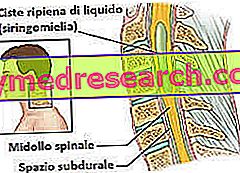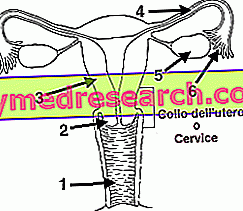Generality
Bleeding hemorrhoids are an annoying consequence of the hemorrhoidal disease.
This condition manifests itself, in particular, with the presence of traces of blood, bright red, visible during evacuation in the toilet or on faeces or, after cleansing, on toilet paper.

In addition to blood loss, bleeding hemorrhoids can be associated, in the early stages, with burning and anal itching .
The factors that contribute to determining bleeding hemorrhoids are different and include chronic constipation, excessive pushes to evacuate, a long stay crouched on the toilet, an unbalanced diet low in fiber, and pregnancy.
Even if it is not a serious condition, bleeding hemorrhoids should not be neglected. In fact, milder cases can be treated with topical application of decongestant drugs . However, a worsening of symptoms may make it necessary to have surgery .
Hemorrhoids or haemorrhoid disease?
In common parlance, the haemorrhoidal disease is called "hemorrhoids". In reality, it is a misnomer, as hemorrhoids ( or hemorrhoidal plexus ) are cushions of richly vascularized tissue, normally present within the anal canal of all people, including healthy ones.
Under certain circumstances, these structures can swell to a greater extent and catch fire. The dilation and inflammation of hemorrhoids can cause prolapses, hematomas, bleeding or thrombi, that is the formation of blood clots inside them. In all these cases, one speaks of haemorrhoidal or hemorrhoidal pathology .
What are
Bleeding hemorrhoids are a manifestation of the hemorrhoidal disease.
Did you know that…
Bleeding and itching are the most common symptoms of inflamed hemorrhoids, often associated with a sense of weight and bulk at the anal level.
Why do hemorrhoids bleed?
Hemorrhoids are cushions of vascular tissue, therefore a spongy tissue filled with blood, formed by capillaries, arteries and above all veins.
From the anatomical point of view, hemorrhoids are divided into:
- Internal : they are located in the anal canal above the imaginary line, called dentate or pectine line, which divides it into two parts, depending on the mucous membrane that covers it;
- External : they are located lower down, at the margins of the anal orifice, therefore lower than the dentate or pectine line.
Just the diversity of the lining mucosa determines, between the two types of hemorrhoids, a different pain sensitivity . In particular, this is absent for internal hemorrhoids, while it is noticeable for external ones.
What are hemorrhoids for?
The function of hemorrhoids is to contribute, together with the anal sphincter, both to evacuation, to the mechanism of continence, therefore to the ability to retain feces, but also liquids and gases. As hemorrhoids are richly vascularized, they are able to expand and deflate through the inflow and outflow of blood within them.
Causes
Bleeding hemorrhoids are a fairly common problem that affects men and women of different ages.
The origin of the haemorrhoidal disease is multifactorial, ie it recognizes more concause.
The predisposing conditions include, in particular:
- Diet poor in water and fiber : if the diet is not balanced and is low in fiber, the intestine cannot function properly. The result is alterations of the alvus (constipation / diarrhea) which are irritating to the hemorrhoidal plexus. Furthermore, certain foods can trigger venous dilation and act as aggravating factors in bleeding hemorrhoids (such as, for example, sausages, alcohol, chocolate, spices and spicy sauces).
- Chronic constipation : prolonged exertion during defecation promotes inflammation of hemorrhoids.
- Pregnancy : in some circumstances, women become more vulnerable to bleeding hemorrhoids. In particular, the female sex can suffer during gestation or immediately after birth; this happens both for the increase in pelvic pressure associated with the presence of the fetus, and for the hormonal changes linked to the pregnancy itself.
- Familiarity : among the factors that can favor hemorrhoids is also the family and personal predisposition to the weakness of the venous walls and to the tendency to the varicose veins also in other bodily districts.
Other causative factors or favoring bleeding hemorrhoids are:
- Life habits : sedentariness, habit of tobacco smoking and practice of some sports, such as horse riding or cycling;
- Obesity and overweight ;
- Drugs - in particular, contraceptives and laxatives;
- Other concomitant diseases, such as portal hypertension resulting from liver cirrhosis, some pelvic neoplasms or prostatic hypertrophy.
Further factors are predisposing the maintenance of the erect station for a long time or the habit of staying a long time sitting on the sanitary vessel, for example to read, as well as defecations too hasty or postponed for various reasons.
The progression of the hemorrhoidal disease occurs due to a blood congestion ; in practice, the latter accumulates in the hemorrhoids dilating them and making them slide downwards. This phenomenon favors on the one hand the lesion of the vessel walls (from which bleeding hemorrhoids result) and on the other it tends to wear down the tissues of the anorectal region, which are forced to bear a greater weight given by the accumulated blood. As a result, the haemorrhoidal veins bleed and tend to protrude downwards, then to prolapse, dragging with it the mucous membrane that covers them.
Symptoms and Complications
The haemorrhoidal disease is the most frequent cause of blood loss from the anus ( proctorrhagia ).
Not always, however, this symptom is due to bleeding hemorrhoids: rectal bleeding can derive, in fact, also from pathologies of different nature, which must be carefully ascertained or excluded in the diagnostic process.

Characteristics of blood loss
Bleeding hemorrhoids are evident due to the appearance of traces of blood during the evacuation (visible in the toilet or on the faeces) or due to the presence of stains on toilet paper after cleansing.
Did you know that…
From the etymological point of view, " hemorrhoid " means blood loss .
The blood losses of bleeding hemorrhoids are always bright red ; in the context of differential diagnosis, this feature is useful for distinguishing the condition from other diseases. Among the symptoms attributable to the haemorrhoid disease, anorectal bleeding is the one to pay more attention to; in its presence, in fact, it is always good to perform medical examinations to rule out other more serious pathologies, including colorectal cancers.
Bleeding hemorrhoids can also occur in the form of dripping or splashing, after the passage of faeces.
Disorders associated with bleeding hemorrhoids
Bleeding hemorrhoids often tend to recur : patients experience the alternation between acute crises and periods of relative relief more or less long.
In addition to blood loss, bleeding hemorrhoids can be associated with other annoying disorders in the anal site, such as:
- Swelling ;
- Anal itching ;
- Burning .
The pain tends to be absent in the initial stages of bleeding hemorrhoids and is more often linked to problems of anal fissures, that is to say cuts at the level of the anus.
In the later stages of the disease, the following may occur:
- Loss of mucus associated with an annoying wet sensation;
- Stimulus at repeated evacuations.
Possible complications
The haemorrhoidal disease can evolve, regardless of the degree, in some complications:
- Over time, if not treated properly, bleeding hemorrhoids can prolapse, that is, escape from the external anal sphincter.
- In more advanced stages, complications such as haemorrhoidal thrombosis may arise. This pathological event can give rise to a very painful acute inflammation, due to the presence of coagulated blood inside the hemorrhoids (both internal and external). On observation, the latter are swollen, tense and bluish.
- Another complication is the choking of prolapsed hemorrhoids, due to the contraction of the anal sphincter. Also in this case the patient will complain of acute pain in the anal region.
- In the case of patients with long-term bleeding hemorrhoids, either as a drip or as a true haemorrhage, one can witness the onset of severe ferroprive anemias, that is due to an iron deficiency.
Bleeding hemorrhoids can also be complicated by the formation of anal or perianal abscesses (around the anus) and fecal incontinence .
Degrees of hemorrhoidal disease
Hemorrhoids are classified into four grades, depending on the severity of the clinical picture:
- 1st degree hemorrhoids : the increase in volume of one or more hemorrhoidal cushions occurs, without prolapse outside the anal margin; cause discomfort, itching and possible bleeding during defecation.
- 2nd degree haemorrhoids: we witness the initial haemorrhoidal prolapse (ie the hemorrhoid leakage from the anal canal), but only after excessive efforts, for example during evacuation or delivery, with subsequent spontaneous reduction. In this case, in addition to bleeding, itching and loss of secretions may also be present.
- 3rd degree hemorrhoids: the haemorrhoidal prolapse is independent of the effort and requires manual reduction to return to the anal canal. In addition to the previous ailments, the symptomatology involves pain and slight faeces loss on the outside, with fouling of the laundry.
- 4th degree hemorrhoids : they are completely prolapsed and cannot be repositioned inside the anus, therefore they always remain outside. Symptoms include pain, intense itching and fecal incontinence.
Diagnosis
Bleeding hemorrhoids are evaluated during an accurate proctological examination which, in addition to paying attention to the patient's clinical history ( anamnesis ), provides:
- Anal inspection : the visual observation of bleeding hemorrhoids allows to highlight the presence, at the level of the anus and the surrounding area, of prolapses, fissures, fistulas, signs of infection, abscesses and marische (cicatricial outcomes of previous traumatic events);
- Rectal exploration : performed by introducing the well lubricated index finger into the rectum; in this way, the doctor can assess the tone of the anal sphincter, appreciate any anomalous masses or hardenings. The digital palpation of the anus and the lower part of the rectum also allows the evaluation of prostate health in men and rectocele problems in women.
- Instrumental examinations : in general, it is very important to arrive at a correct diagnosis that excludes other pathologies. For this reason, the evaluation includes anoscopy (observation of the inner part of the anal canal) or rectosigmoidoscopy (examination of the rectum and sigma). These findings allow us to establish the extent of the prolapse of internal hemorrhoids; moreover, they allow to exclude other anorectal pathologies that produce similar symptoms, for example anal fissures, fistulas, abscesses or colorectal tumors.
Treatment
Bleeding hemorrhoids can be treated with multiple treatment options. The frequency of symptoms is an important factor in planning the most appropriate strategy for the case. When the intervals of well-being are increasingly rare - despite all the hygienic care, the adaptation of the diet and the pharmacological aids - it is necessary to take into consideration the surgery.
Drugs and topical remedies
In milder cases, the doctor may indicate the local application of drugs that can alleviate the symptoms of the disease. The most commonly used medicines are cortisone medications, which have the effect of attenuating inflammation and edema, while local anesthetics, such as lidocaine, help to reduce burning, pain and itching. However, these preparations should only be used for short periods, as they can cause irritation of the anal area.
Some doctors may also prescribe phleboprotectors, to be taken cyclically orally. Examples are the extracts of red vine, witch hazel, butcher's broom or butcher's broom, sweet clover, horse chestnut, blueberry and hesperidin. The same extracts are also present in specific formulations for topical application, then in ointments to be applied at anal level.
Washing with warm water (around 40 ° C) is very effective in alleviating local symptoms, while cold water should be avoided which could lead to the choking of prolapsed hemorrhoids due to anal spasm.
Surgery
The concrete solution to relapses and progressive aggravation of bleeding hemorrhoids is surgery.
Mild bleeding hemorrhoids - If bleeding hemorrhoids are present in mild form, it is possible to resort to outpatient treatments. The most common interventions include:
- Elastic binding : it consists in positioning an elastic rubber string at the base of the hemorrhoids, obtaining strangulation. It follows the necrosis due to the arrest of the blood supply and, after a few days, the spontaneous elimination of the bound tissue and the elastic. Furthermore, the scar and the adhesions that form at the base of the treated part are useful to prevent new prolapses.
- Injective sclerotherapy : involves injections with sclerosing substances, in order to obtain a fibrous scar; the same result can be obtained by infrared coagulation, exploiting the heat generated by a laser beam. The scarring reduces the flow of blood to the prolapsed area and creates adhesions that fix the hemorrhoidal mucosa to the underlying layers, preventing prolapse.
These surgical treatments generally do not cause pain, but it should be noted that their effectiveness is, at times, partial or only transitory.
Severe bleeding hemorrhoids - When bleeding hemorrhoids are more serious and complicated, more complex surgical techniques must be used, under general or regional anesthesia.
The traditional method consists in the hemorrhoidectomy, that is in the removal of the hemorrhoids leaked outside. If the intervention is performed correctly, it is effective and decisive; however, the post-operative course is painful and there is a risk of incontinence.
A more recent technique, called the Longo method, involves the repositioning of the prolapsed hemorrhoids in their original position, without therefore removing them; this makes it possible to significantly limit post-operative pain and accelerate recovery from surgery. The same purpose is pursued by the dearterilalizzazione technique (better known as the THD method ).
In any case, the choice of the most suitable treatment must be made based on the characteristics of the patient and the experience of the surgeon.
To know
The symptoms of bleeding hemorrhoids can be alleviated by first and foremost acting on food and hygiene factors and lifestyle habits. These general measures form the basis of any pharmacological, surgical or phytotherapeutic treatment. Therefore, corrections to diet and lifestyle must ALWAYS be implemented, regardless of any additional treatments.
Prevention
The prevention of bleeding hemorrhoids is based mainly on the change in lifestyle and the adoption of some simple habits . A healthy and balanced diet, combined with regular physical activity, are in fact fundamental elements to counteract the bulging of the mucous membranes that contain the hemorrhoidal cushions.
To maintain regular bowel function and correct constipation, it is necessary to drink at least 1.5-2 liters of water during the day (a habit also useful for keeping the stool soft) and prefer a diet rich in fiber, whole foods, fruit and vegetables . Instead, avoid alcoholic beverages, coffee abuse and irritating foods, such as spices, sausages, fries and chocolate, which also accentuate the symptoms of bleeding hemorrhoids.
Moreover, it is important to indulge the urge to evacuate trying not to hold back, so as not to subject the anorectal zone to excessive stress. Similarly, it should be remembered to avoid excessive and unproductive efforts, which could aggravate the disorder.



